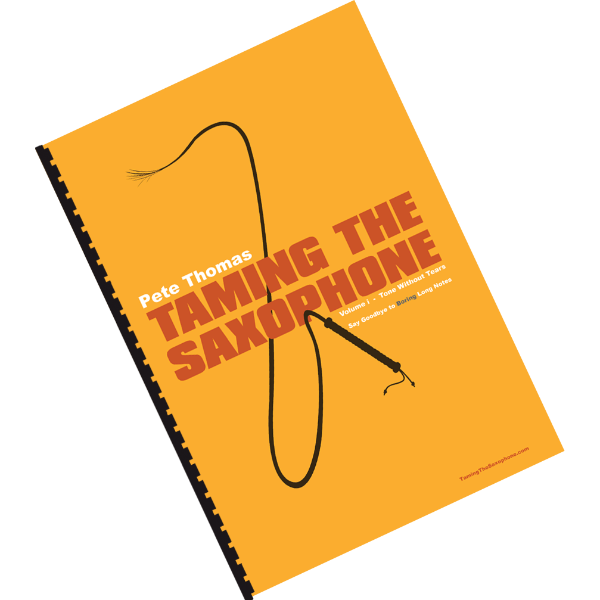Improve your saxophone tone and expression with mouthpiece exercises
You may well wonder what mouthpiece exercises are. There is one well established exercise which some people refer to it as The Mouthpiece Exercise, however it’s definitely not the only one as we shall see.
All of the mouthpiece exercises referred to here are covered in great depth and written out in taming The saxophone Vol 1: Tone Without Tears
The Mouthpiece Pitch Exercise
It’s a common theory that when played by itself (with no saxophone attached) you should get a certain pitch from a mouthpiece. I don’t believe you need to take this as the absolute truth, as the ideal pitch could vary with certain mouthpieces, and there are some styles of music that can work very well with a less conventional embouchure, but as a rough guide when using many mouthpieces this might be quite useful. The pitch you get from just a mouthpiece is determined by a couple of things, the slackness or tightness of your lower jaw and the internal shape and dimensions of your mouth.
I believe that if you don’t get the specified pitch with your normal embouchure, it doesn’t necessarily mean something is wrong, however if you are having problems with your tone and/or intonation, then it can be worth trying this as it may well help.
Mouthpiece Concert Pitch
Soprano: C
Alto: A
Tenor : G
Baritone: D
To test your pitch, first play a note on the saxophone with your normal embouchure with the mouthpiece in its normal position (tune to a keyboard or tuner). Then remove the mouthpiece without changing your embouchure and see what note you get. Compare this to the notes in the box on the right. All you need do now is to try to adjust this pitch to the specified note. You can do this by relaxing your jaw very slightly, but much of the necessary adjustment may come from the internal shape of your mouth and tongue position.
It is very difficult to actually explain what to do, so the best thing is to just try adjusting your tongue position. If you cannot actually reach the pitch don’t worry, settle on one as close as you can comfortable get. Either it will come in time (especially after practicing some of the subsequent exercises) or it could be that these actual pitches do not work as the ideal for your model of mouthpiece.
What can you actually do with just one note?
- Long notes without vibrato
- Long notes with vibrato
- Quiet notes and loud notes
- Crescendos and diminuendos
- Play repeated tongued notes (staccato and legato tongued)
- Play different repeated rhythms and riffs
- Anything else you can think of with one note
More Mouthpiece Exercises
These next exercises are good not just for your embouchure, but also help with ear training (aural ability)
Mouthpiece Glissandi
Play a comfortable note on the mouthpiece (e.g. your normal embouchure). Then, using your jaw and tongue position (as in exercise 1),bend the note slowly upwards as far as possible. Hold for a second or two, then slowly down as far as possible. Hold for a couple of seconds then back to the starting pitch.
You will probably find that you can bend the note a lot more than you can when playing with the mouthpiece on the saxophone. The flexibility you learn from this will help you to adjust the pitch when playing, either for improved intonation or for effects and expression. Keep at this so that you can extend the range that you can bend the pitch, both upwards and downwards.
Mouthpiece Scales
After practicing the first two exercises, by now you should have a good idea of your range. Start on (or bend down to) your lowest note and attempt to play a scale up to your highest note and back down again. Start with something easy like a major scale, but then test your flexibility (and your aural skills) by trying different scales and modes. Major, minor, whole tone, chromatic, diminished etc.
Do this also with different dynamics and articulations.
Mouthpiece Arpeggios
As above, but play arpeggios. Always attempt to extend your range throughout all these exercises, but mostly aim for good intonation. If in doubt get a digital tuner. Eventually you should be working towards being able to hear when your intonation is accurate or not.
Mouthpiece Melodies
This is just what it says on the tin: play some tunes on the mouthpiece alone. Have fun, although the neighbours may not be. Speaking of which there is a very handy gizmo that you can use to make the mouthpiece exercises a little less loud, this is the mouthpiece silencer made by Jazzlabs

